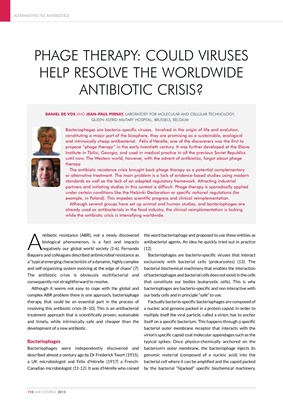
ALTERNATIVES TO ANTIBIOTICS
110 AMR CONTROL 2015
A
ntibiotic resistance (ABR), not a newly discovered
biological phenomenon, is a fact and impacts
negatively our global world society (1-6). Fernando
Baquero and colleagues described antimicrobial resistance as
a "typical emerging characteristic of a dynamic, highly complex
and self-organizing system evolving at the edge of chaos" (7).
The antibiotic crisis is obviously multifactorial and
consequently not straightforward to resolve.
Although it seems not easy to cope with the global and
complex ABR problem there is one approach, bacteriophage
therapy, that could be an essential part in the process of
resolving this antibiotic crisis (8-10). This is an antibacterial
treatment approach that is scientifically proven, sustainable
and timely, while intrinsically safe and cheaper than the
development of a new antibiotic.
Bacteriophages
Bacteriophages were independently discovered and
described almost a century ago by Dr Frederick Twort (1915),
a UK microbiologist and Félix d'Hérelle (1917) a FrenchCanadian
microbiologist (11-12). It was d'Hérelle who coined
the word bacteriophage and proposed to use these entities as
antibacterial agents. An idea he quickly tried out in practice
(12).
Bacteriophages are bacterio-specific viruses that interact
exclusively with bacterial cells (prokaryotes) (13). The
bacterial biochemical machinery that enables the interaction
of bacteriophages and bacterial cells does not exisit in the cells
that constitute our bodies (eukaryotic cells). This is why
bacteriophages are bacterio-specific and non interactive with
our body cells and in principle "safe" to use.
Factually bacterio-specific bacteriophages are composed of
a nucleic acid genome packed in a protein capsid. In order to
multiply itself the viral particle, called a virion, has to anchor
itself on a specific bacterium. This happens through a specific
bacterial outer membrane receptor that interacts with the
virion's specific capsid coat molecular appendages such as the
typical spikes. Once physico-chemically anchored on the
bacterium's outer membrane, the bacteriophage injects its
genomic material (composed of a nucleic acid) into the
bacterial cell where it can be amplified and the capsid packed
by the bacterial "hijacked" specific biochemical machinery.
PHAGE THERAPY: COULD VIRUSES
HELP RESOLVE THE WORLDWIDE
ANTIBIOTIC CRISIS?
DANIEL DE VOS AND JEAN-PAUL PIRNAY, LABORATORY FOR MOLECULAR AND CELLULAR TECHNOLOGY,
QUEEN ASTRID MILITARY HOSPITAL, BRUSSELS, BELGIUM
Bacteriophages are bacterio-specific viruses. Involved in the origin of life and evolution,
constituting a major part of the biosphere, they are promising as a sustainable, ecological
and intrinsically cheap antibacterial. Félix d'Hérelle, one of the discoverers was the first to
propose "phage therapy" in the early twentieth century. It was further developed at the Eliava
Institute in Tbilisi, Georgia, and used in medical practice in all the previous Soviet Republics
until now. The Western world, however, with the advent of antibiotics, forgot about phage
therapy.
The antibiotic resistance crisis brought back phage therapy as a potential complementary
or alternative treatment. The main problem is a lack of evidence-based studies using modern
standards as well as the lack of an adapted regulatory framework. Attracting industrial
partners and initiating studies in this context is difficult. Phage therapy is sporadically applied
under certain conditions like the Helsinki Declaration or specific national regulations (for
example, in Poland). This impedes scientific progress and clinical reimplementation.
Although several groups have set up animal and human studies, and bacteriophages are
already used as antibacterials in the food industry, the clinical reimplementation is lacking
while the antibiotic crisis is intensifying worldwide.